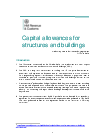Draft legislation detailing a new capital allowance for new non-residential structures and buildings
Download the full outcome
Detail of outcome
At Autumn Budget 2018, the government published a technical note for consultation that outlined the key features of a new capital allowance for non-residential structures and buildings (SBA). Businesses that invest in new builds or renovations on or after 29 October 2018 will be able to claim tax relief at 2% a year on eligible costs.
At Spring Statement 2019, the government published detailed draft legislation and invited further comments from stakeholders.
As a result of the consultation process some features have been amended, including those relating to short-term leaseholds, eligible pre-trading costs, periods of disuse, and reducing claimants’ administrative burdens.
Legislation to provide for this new capital allowance was laid before Parliament and came into force, in line with its commencement provisions, on 5 July.
Guidance will be published in the next few weeks.
You can read:
- The Capital Allowances (Structures and Buildings Allowances) Regulations 2019, including an explanatory memorandum
- a tax information and impact note
Original consultation
Consultation description
The Structures and Buildings Allowance will help to support business investment in the UK, improve the case for developing new structural assets and enhance tax relief for such assets.
The technical note published at Budget 2018 outlined the key features of the policy and included consultation questions on residential use exclusion, leasing provisions, overseas property treatment and disuse provisions.
For the second part of the consultation process, the government invites views on the legislative detail, before it is laid before and approved by the House of Commons.
An overall response to consultation responses will be published in May 2019 and the final published version of this legislation will be in the form of a Statutory Instrument.
The published document consists of:
- An introductory note which briefly reiterates the scope and design of this new allowance as set out in the technical note published at Budget 2018. This includes a short section outlining how some technical elements of the policy design have changed following engagement with stakeholders so far in the consultation process.
- The draft secondary legislation that provides the legal basis for this new allowance. This sets out in detail the treatment for relieving expenditure at the inception of the new asset and after that. It explains the circumstances in which relief can be provided or transferred, including important exclusions such as land-related costs or residential use. Once in force, the legislation will apply to eligible costs incurred on or after 29 October 2018, in line with the commencement provisions.
Documents
Last updated 16 July 2019 + show all updates
-
Updated to reflect that the regulations have come into force.
-
Added outcome summary and consultation response document.
-
First published.

